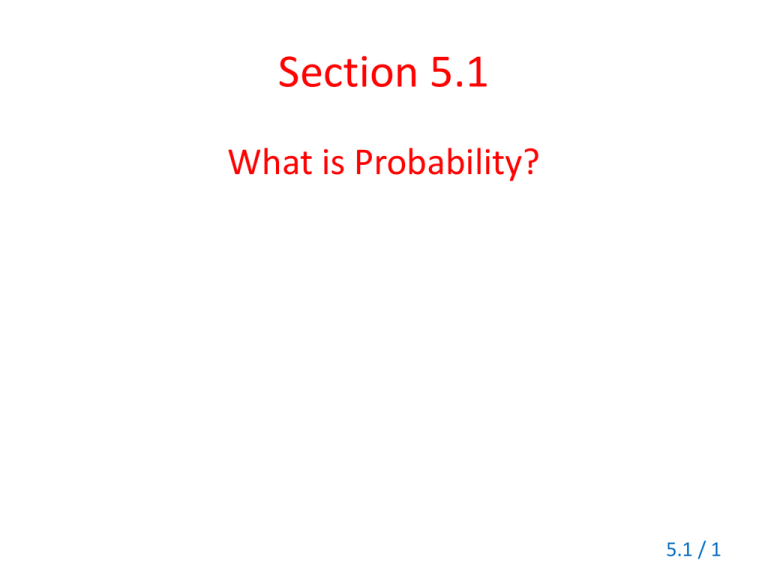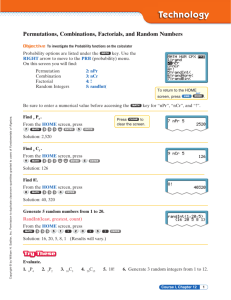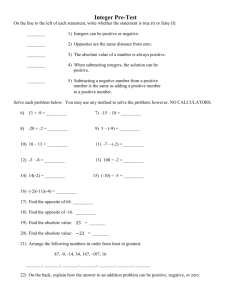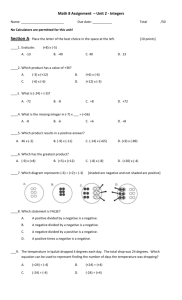Section 5.1 - USC Upstate: Faculty
advertisement

Section 5.1
What is Probability?
5.1 / 1
Probability
• Probability is a numerical measurement of
likelihood of an event.
• The probability of any event is a number
between zero and one.
• Events with probability close to one are more
likely to occur.
• Events with probability close to zero are less
likely to occur.
5.1 / 2
Probability
• Probabilities are assigned
values from 0 to 1.
• The closer the probability
of a given event is to 1,
the more likely it is that
the event will occur.
• The closer the probability
of a given event is to 0,
the less likely that the
event will occur.
3
Probability Notation
If A represents an event,
P(A)
represents the probability of A.
If P(A) = 1 Event A is certain to occur
If P(A) = 0 Event A is certain not to occur
5.1 / 4
Three methods to find probabilities:
• Intuition
• Relative frequency
• Equally likely outcomes
5.1 / 5
Intuition Method of Determining
Probability
• Incorporates past experience, judgment, or
opinion.
• Is based upon level of confidence in the result
• Example: “I am 95% sure that I will attend the
party.”
5.1 / 6
Probability as
Relative Frequency
Probability of an event =
the fraction of the time that the event occurred
in the past =
f
n
where f = frequency of an event
n = sample size of n observations
5.1 / 7
Example of Probability as
Relative Frequency
If you note that 57 of the last 100
applicants for a job have been female,
the probability that the next applicant is
female would be:
57
100
8
Equally Likely Outcomes
• No one result is expected to occur more
frequently than any other.
When outcomes are equally like
Probability of an event
Number of outcomes favorable to event
Total number of outcomes
5.1 / 9
Example of Equally Likely Outcome
Method
When rolling a die, the probability of getting
a number less than three =
2 1
6 3
Example
A die is rolled once. The sample space is S =
{1,2,3,4,5,6} Find the probability of rolling
a. a 3
b. an even number
Solution to a:
P(3) = number of outcomes favor to 3 = 1/6
total number of outcomes
Solution to b:
Rolling an even number describes the event {2,4,6}.
This event can occur in 3 ways:
P(even number) =
number of outcomes favor to even number =
total number of outcomes
3/6 = 1/2
5.1 / 11
Example
• You are dealt one card from a standard 52-card
deck. Find the probability of being dealt a
a. King
Solution:
4
1
P(King) = number of outcomes favor a king = 52 13
total number of outcomes
b. Heart
Solution:
P(heart) = number of outcomes favor to a heart =
total number of outcomes 13 1
52
4
5.1 / 12
Law of Large Numbers
In the long run, as the sample size increases and
increases, the relative frequencies of
outcomes get closer and closer to the
theoretical (or actual) probability value.
5.1 / 13
Statistical Experiment or Statistical Observation
Is any random activity that results in a definite
outcome
Event
Is a collection of one or more outcomes of a
statistical experiment or observation
Simple Event
Is an outcome of a statistical experiment that
consists of one and only one of the outcomes of
the experiment
5.1 / 14
Sample Space
• Is the set of all possible distinct outcomes of
an experiment
• The sum of all probabilities of all simple
events in a sample space must equal one.
• Example: Sample Space for the rolling of an
ordinary die: 1, 2, 3, 4, 5, 6
5.1 / 15
For the experiment of
rolling an ordinary die:
• P(even number) =
3 1
6 2
4 2
6 3
• P(result less than five) =
• P(not getting a two) =
5
6
Complement of Event A
• the event that A does not occur
• Notation for the complement of event A:
A
c
Event A and its complement Ac
Probability of a Complement
P(event A does not occur) = P(Ac) = 1 – P(A)
So, P(A) + P(Ac) = 1
5.1 / 18
Probability of a Complement
If the probability that it will snow today
is 30%,
P(It will not snow) = 1 – P(snow) =
1 – 0.30 = 0.70
5.1 / 19
Probability Related to Statistics
• Probability makes statements about what will
occur when samples are drawn from a known
population.
• Statistics describes how samples are to be
obtained and how inferences are to be made
about unknown populations.
5.1 / 20
Generating Random Numbers (calc)
Random numbers can be quickly and easily generated by using the
graphing calculator.
Let's start our investigation by looking at generating random
integers.
(The TI-84+ is being used on this page.)
Generating Random Integers on the Home Screen: (good for games)
Go to MATH → PRB Choose #5 randInt(
From the home screen, enter the smallest value needed, followed
by the largest value. Hitting ENTER will generate the random
integers.
(Random values may repeat.)
This example generates random numbers from 1 to 25 (good for
Bingo).
Adding a third parameter indicates the number of random
integers that will appear on the screen at one time.
5.1 / 21
Generating Random Numbers (calc)
Generating Random Integers in Lists: (good for statistical studies)
Go to MATH → PRB Choose #5 randInt(
From the home screen, enter the randInt followed by the smallest
value in the desired range, the largest value, and the number of
terms needed. The results are stored (STO) into List 1.
This example stores 100 random integers from 0 to 1 in L1 to
simulate the toss of a coin.
OR, from the list screen, arrow up onto L2, and type
randInt(0,1,100). Hit ENTER.
Be sure to enter the third parameter so the calculator will know
"how many" numbers to place in the list.
Such lists can be used to simulate the toss of one (or more) fair
coin(s). The number of entries represents the number of
tosses. An even random number represents heads, while an odd
number represents tails.
If tossing one coin, use sum command to count the number of heads,
where heads are 1, and tails are 0. 2nd STAT - MATH - #5 sum
5.1 / 22
Generating Random Numbers (calc)
Using the rand command: (not integers)
The rand (MATH → PRB #1 rand) command will generate random
values, not integers.
MATH → PRB #1 rand
The rand command will create a random number between 0 and 1.
To generate a random number between 0 and 15, enter
rand*15.
This last entry shows how to generate a list of 10 random numbers
between 0 and 15 and store them in List 1.
5.1 / 23
Generating Random Numbers (calc)
Re-Seeding the Random Number Generator:
Calculators (and computers) are not capable of creating "truly
random" numbers. They create what are called "pseudo-random"
numbers, meaning they use a formula to create the values. To
engage this formula, the calculator uses a starting value, called a
"seed", and then creates the random numbers based upon this
seed. If two calculators start with the same seed value, they will
generate the same sequence of random values.
If you wish, you can control the starting "seed" value.
To seed the random generator,
choose a seed value and store
it into the rand command.
5.1 / 24
Generating Random Numbers (calc)
Now, start generating your random values.
If you feed two calculators the same seed value, they will each
produce the same result when rand is entered.
After running a RESET (DEFAULTS) the calculator will return to
using its default seed value. Engaging rand will always produce
the value seen above. This same value will appear on all TI-84+
calculators after a reset.
If you wish to ensure that each student in the class has a
different set of random numbers, assign a different number to
each student as their seed value. You could also have the
students enter their birth date as the random seed (04021990),
assuming no two students have the same birth date.
5.1 / 25





